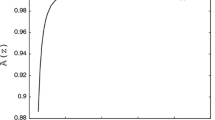Abstract
The wave function and energy of the ground state of a lattice described by the Su–Schrieffer–Heeger Hamiltonian with a trap were found using three different methods. In the first of these methods, the energy of the ground state was calculated by numerical minimization of the energy functional. In the second, an auxiliary Hamiltonian was constructed, the diagonalization of which determined the energy of the ground state and the wave functions. And in the third, the wave function is completely restored analytically from the asymptotics of the wave function. All the three approaches produced results that agreed with an accuracy of 10–15.



Similar content being viewed by others
REFERENCES
W. P. Su, J. R. Schrieffer, and A. J. Heeger, Phys. Rev. B 22, 2099 (1980).
E. M. Conwell and S. V. Rakhmanova, Proc. Natl. Acac. Sci. U. S. A. 97, 4556 (2000).
E. M. Conwell and D. M. Basko, Synth. Met. 137, 1381 (2003).
G. Zhang, H. Hu, Sh. Cui, and Z. Lv, Phys. B (Amsterdam, Neth.) 405, 4382 (2010).
D. J. J. Marchand, G. De Filippis, V. Cataudella, et al., Phys. Rev. Lett. 105, 266605 (2010).
V. M. Kucherov, C. D. Kinz-Thompson, and E. M. Conwell, J. Phys. Chem. C 114, 1663 (2010).
V. D. Lakhno, Int. J. Quant. Chem. 108, 1971 (2008).
V. D. Lakhno and V. B. Sultanov, Mat. Biol. Bioinform. 4 (2), 46 (2009).
K. E. Augustyn, J. C. Genereux, and J. K. Barton, Angew. Chem., Int. Ed. 46, 5731 (2007).
J. C. Genereux and J. K. Barton, Chem. Rev. 110, 1642 (2010).
J. D. Slinker, N. B. Muren, S. E. Renfrew, and J. K. Barton, Nat. Chem. 3, 228 (2011).
Y. Ono and A. Terai, J. Phys. Soc. Jpn. 59, 2893 (1990).
A. A. Johansson and S. Stafström, Phys. Rev. B 69, 235205 (2004).
Y. Yao, Y. Qiu, and Ch.-Q. Wu, J. Phys.: Condens. Matter 23, 305401 (2011).
T. Astakhova and G. Vinogradov, Eur. Chem. Bull. 7, 172 (2018).
Author information
Authors and Affiliations
Corresponding author
Additional information
Translated by V. Glyanchenko
Appendix
Appendix
Let us write the initial functional to be minimized in the form
Let us minimize this functional as follows. Initially, we choose some initial set of coordinates yj, e.g., an exponentially decreasing function: yj ~ exp(–| j|). Using these yj values, we minimize the functional in \(\Psi .\) If the wave function \(\Psi \) is the ground state of the Hamiltonian He, then we obtain the minimum energy. This problem can be solved differently and, e.g., the energy in yj can begin to be minimized using a gradient method. Then, at each step, the functional should be minimized over all the values of \(\Psi .\) This means that, in the course of this process, the system is always in the ground state of the Hamiltonian He. The minimum is reached if \({{y}_{j}} = - 2\alpha {{\Psi }_{{j + 1}}}{{\Psi }_{j}}.\) And then the wave function is the ground state of the Hamiltonian He. It may seem that the obtained coincidence of the minimum of the functional and the ground state of the corresponding Hamiltonian is fully accidental. But this is not the case. One can give a wealth of examples of such a correspondence. For example, let us consider the Hamiltonian with an arbitrary diagonal nonlinearity:
If, e.g., f(Ψ) = Ψ2, then this a discrete variant of a nonlinear Schrödinger equation. It turns out that, for any function f(Ψ), one can match a functional the minimum of which corresponds to the ground state of the considered Hamiltonian.
Rights and permissions
About this article
Cite this article
Likhachev, V.N., Vinogradov, G.A. Polaron on a Lattice with a Trap in the Su–Schrieffer–Heeger Approximation. Russ. J. Phys. Chem. B 14, 222–226 (2020). https://doi.org/10.1134/S1990793120020098
Received:
Revised:
Accepted:
Published:
Issue Date:
DOI: https://doi.org/10.1134/S1990793120020098



